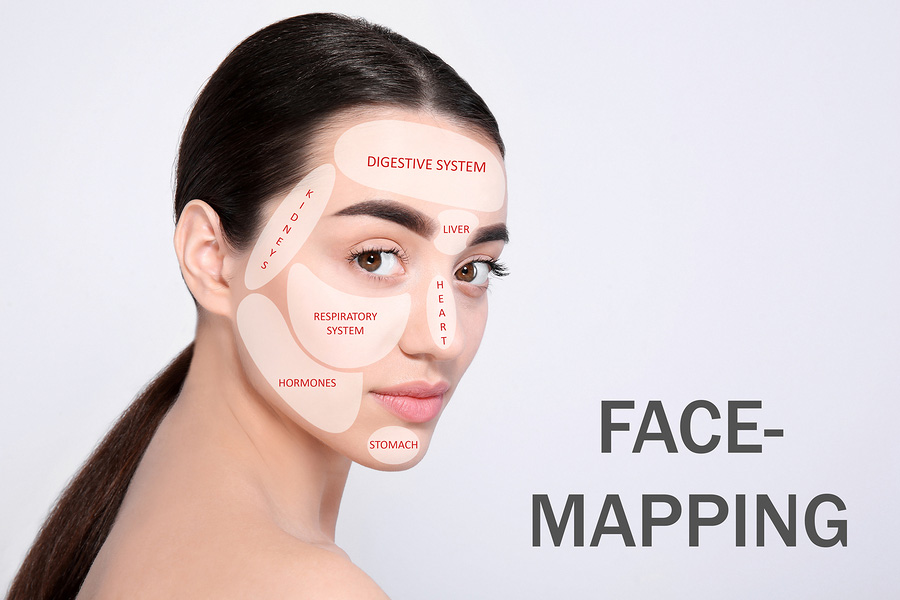You probably remember skimming the pages of your favorite teen magazine for tips about breakouts. Phrases like “T-zone” likely call to mind fresh-faced commercials for the hottest acne cleanser represented by a top actress. And today, pop culture has been looking to Eastern medicine for skincare advice more than ever.
One of the most popular Eastern medicine skincare practices is face mapping. This ancient Chinese practice interprets the condition of your complexion as a reflection of your internal health. Readily available face maps online show colorful blobs overlaid on a person’s face, labeled with internal organs. If your breakouts have you stumped, reading up on face mapping can give you much-needed insight.
1. Your Skin is Telling You Something
If one thing is immediately evident by face mapping graphics, is that each section of your skin points inward. Consistent breakouts in concentrated areas may suggest that you’re having trouble inside your body, not just on the surface. As you deploy your acne treatment, you may notice progress in some areas while others have persistent issues. If this is the case for you, you might need to address internal issues as well.
Breakouts across your cheeks can point to stomach and intestine issues, which can’t be resolved by topical applications. If you suffer from irritable bowel syndrome or have a food intolerance or allergy, it may show up on your face.
Similarly, reproductive issues can show across the entirety of your chin. For women, this may flare up during hormonal shifts or more frequently and aggressively with polycystic ovarian syndrome. If you have internal issues that you aren’t managing according to your care team’s instruction, it’ll show on your face.
2. Breakouts Follow a Pattern
Take note of what you see on your face and feel inside your body. Start a skincare diary and write down in detail everything that goes into and on your body. Include sleep, nutrition, activities, along with breakout locations and severity. After several weeks, review your notes to see if you can identify a pattern.
Women should aim to complete this exercise across two or more menstrual cycles to get an accurate hormonal read. How your hormones shift across a cycle varies greatly, and having more than one cycle to examine can be helpful.
Many people see recurring acne each month, which can mean multiple things. Sometimes, an ingrown hair is the culprit. Other times, it’s a deeply clogged pore that could use a professional extraction. Comparing breakout patterns to a face map may also indicate an internal imbalance worth exploring with a professional.
3. Lifestyle Choices Have an Impact
If everyone’s favorite high school health teacher said one consistent thing, it’s that your lifestyle choices impact your health. Beyond the obvious understanding that poor nutrition puts your body at a disadvantage, how you care for yourself matters.
Poor sleep, unbalanced nutrition, and stress can put your internal organs into overdrive, compensating for gaps you’ve created. While the body is resilient and can handle some abuse, there are limitations to its abilities. When you’ve put too much pressure on your system, the body can use your face as a warning flag to communicate.
Breakouts can begin to emerge between your brows if you’ve adopted an all snack food diet. Similarly, your under eye area can appear puffy or dark if you’ve skipped water in lieu of dehydrating coffee. Stress and menstrual cycle changes can incite breakouts across the chin, as can bad habits like face touching.
4. Your Body’s Unique Composition Plays a Role
It can be tempting to look to your friends for comparison on matters beyond skincare. But just like they’re on their unique life journey, so too are you with your skin. Even if you share similar lifestyles, your genetic makeup is going to influence your skin’s behavior and skincare needs.
Instead of getting frustrated about your friend’s clear complexion — or even worse, that of a celebrity — examine your lineage. Some ethnic backgrounds have commonalities when it comes to skin conditions and breakouts. Those with more melanin, often experience more sun resiliency and less wrinkles. Others with more fair complexions often need to manage redness and darkness under the eyes due to the skin’s lightness.
Speak with close relatives like your parents and siblings to better understand your breakout patterns. If your family historically has oily noses and chins, you can better develop a way to manage them. Use face mapping as a guide to compliment what you learn about your unique composition to get the best results.
Blend Holistic Skincare With Traditional Methods for a Comprehensive Regimen
Your skin is dynamic, and its condition will change with time and lifestyle impacts. As you develop your skincare regimen, consider how you can layer traditional practices with holistic ones. While ancient techniques like gua sha, reflexology, and massage can’t replace prescription acne treatment, they can improve overall skin condition.
Sample various techniques for a few weeks, logging their impact on your skin. If you see results and can keep up with the recommended regimen, add it to your routine. With a blended approach, you’ll get the best of science-backed products and time-tested methods for your best skin ever.



